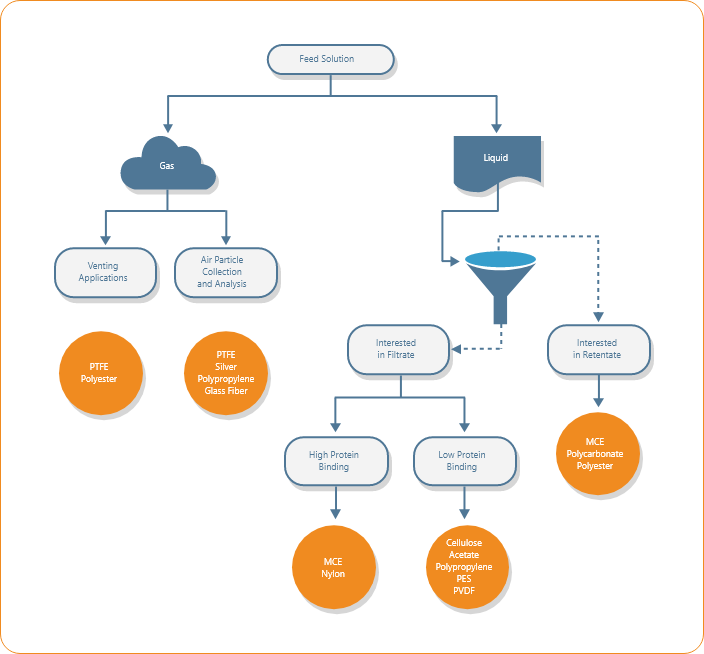There are many options to choose from when selecting a filter disc - how do you know which is best for your application?
1. Pick a suitable membrane material
What’s the nature of your solution to be filtered?
Gas
• If you are using the membrane as a vent for a gas stream: Hydrophobic PTFE and Polyester (PETE)
• For air particle collection on the membrane surface: PTFE, Silver, PP, and Glass Fiber
Liquid – see next question
What is your desired end product?
• Interested in particles retained on the membrane surface
Polycarbonate (PCTE) and PETE for easy surface retrieval/microscopy
MCE for retention and plating of bacteria from solution
• Interested in the filtered fluid
MCE and Nylon have high protein-binding capacity for sterilization
Cellulose Acetate, PES, PP, and PVDF have good flow rates
PAN is designed for fast water purification

2. Decide an appropriate pore size
The pore size of a filter, stated in microns (aka micrometers or µm), is determined by the diameter of particles retained by the filter or by a bubble point test
• Nominal ratings are the pore size at which a particle of defined size will be retained with an efficiency below 100% (typically 90-98%)
Rating methods differ widely between manufacturers
• Absolute ratings are the pore size at which a particle of defined size will be retained with 100% efficiency under specified test conditions
0.2 µm sterilizing filter will retain 10 organisms per cm² of Pseudomonus diminuta at 30 psig and ambient temperature
Fun fact: Due to viscosity differences, a 0.2 micron pore size rated membrane in liquid can retain up to 0.02 micron particles in air
What size are the particles you would like to filter?
• Particle filtration: 5.0+ microns
• Microfiltration: 0.1 - 5.0 microns
• Ultrafiltration: 0.01 - 0.1 microns
• Nanofiltration and Reverse Osmosis: 0.001 microns (theoretical)
Select a pore size (or a few pore sizes to try) that retains the desired particles - see the table for some example applications using various membrane pore sizes
- Chemotaxis
- Cytology
- Separation of samples by size
- Epiflourescense
- Liposome Extrusion
- Virus Filtration
- Mycoplasma removal
- Bacteria Removal
- Sterilization
- Clarification
- HPLC Sample Preparation
- Prefilter
- Microbiological analysis
- Protein, enzyme filtration
- Venting Application
- Sterility Testing
- SEM
- Trace metal analysis
- Particle Analysis
- Filtration of corrosive
- solutions
- Removal of RBC from
- Plasma
- Toxicity testing
- Serum prefiltration
- General filtration
- Particulate Analysis
- Medical Assays
- Immobilizations
- Chemotaxis
- Red Blood Cells
- DNA
- NIOSH Methods
- X-ray diffraction
- Filtration of corrosive
- solutions
- Cytology
- Large Bacteria Filtration
- Cancer Cell Studies
- Metastasis tumor cells
- Schistosoma Filtration
- Chemical Filtration
- Alcohol Filtration
- Chemical Filtration
- General Filtration
3. Choose the right filter disc diameter
Utilize the table to see what filter size is recommended to filter your sample volume
| Diameter of Membrane | Volume of Solution |
|---|---|
| 3 mm | < 1 mL |
| 13 mm | < 5 mL |
| 17 mm | < 12 mL |
| 25 mm | < 100 mL |
| 30 mm | < 120 mL |
| 47 mm | < 1 L |
| ≥ 90 mm | > 1 L |

